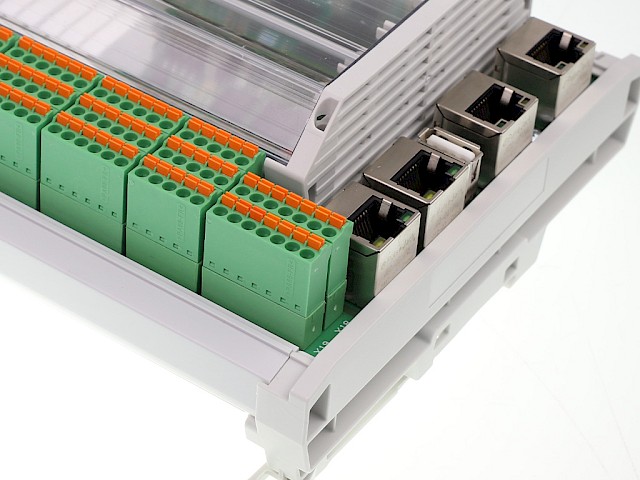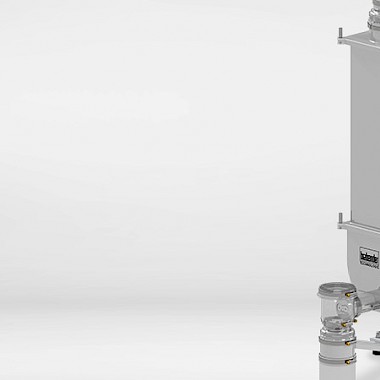New controller generation
High performance: fit-for-the-future controllers
Kubota Brabender Technologie’s new control module generation is laying the foundations for a smart equipment future.
Sophisticated software solutions and flexible interfaces
There is more to fully automatic feeding than just precision weighing technology. A smart control system featuring sophisticated software solutions and flexible interfaces forms the centerpiece of any feeding facility. It not only controls the feeding process through the complex interaction of its weighing and control functions, but also interconnects gravimetric feeders with other system components, like refill devices and shut-off valves. Above all, it provides complete documentation – a must in modern production plants, not least in terms of being a prerequisite for quality management system certification. This smart system enables process lines featuring single or multiple Kubota Brabender Technologie feeders to be controlled, as they can communicate directly with most host/PLC systems. Controls can be feeder-mounted or installed in control cabinets.
Laying foundations for the future
The new Congrav® CM-E 3.0 and Congrav® CB-E 3.0 control modules, launched in 2021, are enabling Kubota Brabender Technologie to lay high-performance foundations for the future, in which the Internet of Things (IoT) will play a major role alongside predictive maintenance and equipment monitoring. “Processor performance and the new controller’s memory were developed with the future and not the present in mind,” Jörg Pawlik, Head of Electronic Systems Development at Kubota Brabender Technologie, explains.
The controller is fitted with several sophisticated Advanced RISC processors. They form the basis of an energy-efficient, high-performance platform and provide all the necessary computational functions, to enable the gravimetric feeders to operate properly. They are therefore suitable for use in exacting industrial environments. Two main processors (CPUs) with five cores ensure that all communication, computational and distribution processes are even more efficient and high-octane. The software has been fundamentally enhanced in terms of upgradeability, in order to make optimum use of the new hardware.
This is what the new Congrav CM-E and CB-E 3.0 controllers can do
Featuring six digital inputs and six digital outputs, more functions can be assigned than on the previous generation of control modules. For example, the inputs are utilized for the stop/start function or for interlock purposes, while the outputs are used for operating, refilling (for instance via the slide gate above the feeder) or alarm purposes.
Like their predecessors, the new controllers provide a range of interfaces, however these have been enhanced using state-of-the-art ethernet technology. The previous digital and analog RS 485 add-on units therefore function as an ethernet interface, which no longer requires the use of digital I/O interfaces to connect add-on units.
The new controller generation features a web interface, which enables fast, uncomplicated diagnosis and parameter setting using multiple mobile devices.Ingo Röpling, Head of Software Development at Kubota Brabender Technologie
En route to smart devices
It will soon be possible to establish a network connection between two terminals, so-called sockets, using another new interface, the TCP (Transmission Control Protocol) network protocol. The controller can share data in both directions with other computers using this link. That lays the network-relevant foundation for the Internet of Things, where plant and equipment with an electronic intelligence capability are transformed into smart devices that communicate with one another.
“The controllers also provide a web interface that ensures Internet and cloud connections,” says Röpling. “On customer request and following customer approval, data can be analyzed in realtime via the Internet or a dedicated customer cloud. This enables us to assist customers as quickly as possible, for example when responding to service inquiries. We are therefore laying the groundwork for Internet of Things and Industry 4.0 integration, and building a bridge into the future.”
New predictive maintenance opportunities
Another new feature is the controller’s integrated ‘real time clock’. It also operates when the controller is switched off. For example, it can provide accurate information about when the equipment was powered up for the first time after delivery. That is important where warranty issues are involved, as well as enabling the correct maintenance intervals to be adhered to, for example. “The new technological foundation that the Congrav® CB-E controllers represent has provided us with these diagnosis and predictive maintenance opportunities,” Jörg Pawlik states. All of four ethernet interfaces provide extra capacity for the hardware – not just for IoT tasks, but also, for example, for the host interface (incl. Profinet, OPCUA, Ethernet IP), diagnosis, maintenance or operating panel.
Additional upgrade options
To date it has only been possible to connect three I/O interfaces. Up to 63 modules can now be connected to control external add-ons. “That increases the options many times over,” Jörg Pawlik emphasizes. A mini-PCI express slot and slots for future add-in cards like WLAN or Bluetooth modules, were also factored in.
In launching our new generation of controllers, we have laid extensive foundations and provided a wide range of options for ensuring that our equipment has a smart future.Jörg Pawlik, Head of Electronic Systems Development at Kubota Brabender Technologie
Guaranteed backward compatibility
The new generation of controllers can be operated using the Congrav® OP1-S (for one feeder), Congrav® OP6-E (for a maximum of six feeders) or Congrav® OP16-E (for a maximum of 16 feeders) operating panels. Ingo Röpling emphasizes: “We ensured that both the new controller hardware and software feature backward compatibility with almost all older Kubota Brabender Technologie controllers and operating panels. It is therefore also possible to connect the new controller using our proprietary fieldbus, if a TCP connection is not feasible.”
Data security and wider security issues
The launch of a new, separate security chip demonstrates that attention was also paid during development to the increasingly important issue of security, which is vital to the protection of customer data and of the hardware. A further security aspect is covered by the integrated sensor chip: the 3-axis sensor can record vibrations or motion in three directions. This enables ambient conditions like temperature and humidity to be analyzed extremely accurately. “That is not just a factor in subtropical countries, but can also be useful in Europe,” Jörg Pawlik clarifies.
Separate supply voltages and supercaps
Separate supply zones have been installed in the controller: 24 volts for the controller with the CPUs and another 4 volts for the I/O inputs and outputs. Furthermore, the voltage range has been extended to 14-36 volts, which results in increased hardware stability. Even more major voltage fluctuations have no impact on the controller’s operational reliability.
The supercaps installed in the controller provide comprehensive protection in the event of power supply fluctuations. Boasting sufficient backup capability, they ensure the power supply when mains voltage drops. Pawlik explains: “You can visualize that in the form of two small batteries that release energy as soon as there is a power cut. That is important, especially in countries where electricity grids are volatile.”
Self-remedying fuses
Self-resetting fuses protect equipment in the event of overcurrent like any conventional fuse. Electronics expert Jörg Pawlik says: “In contrast to a normal fuse, which is not reusable, this fuse ‘remedies’ itself. This adds a service aspect to the equation, as the fuse no longer needs to be replaced.”
Enhanced reverse polarity protection
To date controllers have featured a reverse polarity protection detail that prevents the controller from starting if poles are connected incorrectly. The new-generation controllers incorporate a so-called rectifier. No matter how you connect the 24 volts – the controller always operates. “It can no longer be plugged in incorrectly,” says Jörg Pawlik with a grin.
The electronic system developers have also given thought to drive technology controls. With the old controller, the drive type always had to be identical if multiple drives were used: either two three-phase current motors or two smart DC motors for screws and agitators or paddles. The new control technology now enables a mix of drive technologies. For example, a smart DC motor can now be used for the screws and a three-phase current motor for the paddle, which helps to achieve greater efficiency.
Would you like to find out how to incorporate our new generation of controllers into your processes?
Our expert Jörg Pawlik is happy to advise you.
Looking ahead
Following the launch phase, Jörg Pawlik is able to draw some positive conclusions: “In launching our new generation of controllers, we have laid extensive foundations and provided a wide range of options for ensuring that our equipment has a smart future. We look forward to traveling down this road together with our customers and will continue to work on making our equipment’s control processes even more efficient.”




